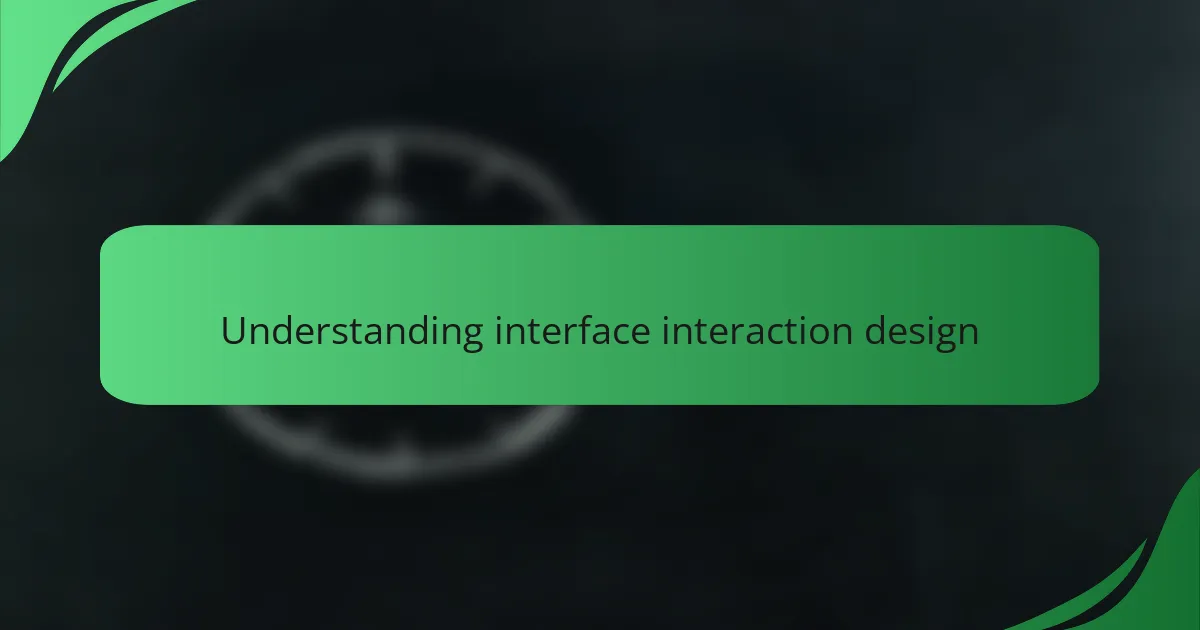Key takeaways
- Interface interaction design prioritizes user communication and empathy, significantly influencing overall satisfaction.
- User evaluation, particularly through tools like UserZoom, enables continuous improvement in design by addressing user needs and perceptions.
- UserZoom features, such as remote testing and heatmaps, provide immediate insights and enhance understanding of user behavior.
- Design improvements should be viewed as an ongoing journey, driven by consistent user feedback and the pursuit of intuitive interfaces.

Understanding interface interaction design
Understanding interface interaction design is crucial for creating user-friendly experiences. From my perspective, interaction design is all about how users communicate with a product or system. It not only involves the visual elements but also the way these elements respond to user actions, which can significantly influence their overall satisfaction.
I remember a particular project where evaluating site content through UserZoom significantly improved our understanding of user behavior. Seeing how users interacted with our designs highlighted their pain points and preferences, which ultimately helped us refine our approach. This hands-on experience taught me that effective interaction design hinges on empathy – always putting the user’s needs first.
Here’s a comparison of traditional evaluation methods versus using UserZoom:
| Aspect | Traditional Methods | UserZoom |
|---|---|---|
| Data Collection | Surveys and focus groups | Remote user testing and heatmaps |
| Real-time Feedback | Delayed insights | Immediate reactions from users |
| User Engagement | Limited interaction | In-depth, rich user interactions |

Importance of user evaluation
User evaluation plays a pivotal role in shaping effective designs. I’ve witnessed firsthand how insights gained from users can transform a good interface into a great one. For instance, during a recent project evaluation using UserZoom, I was struck by how a simple change in wording could make a significant difference in user comprehension. It made me question: Are we truly listening to our users?
The emotional aspect of user feedback cannot be overstated. When I saw how relieved users were after their frustrations were addressed thanks to our changes, it reinforced my belief in the power of evaluation. Their reactions provided a direct link to our design decisions, and I felt a genuine connection, realizing that my work could deeply impact their experience.
Additionally, continuous user evaluation fosters a culture of improvement. I remember thinking about our iterative design process; each round of feedback made us bolder in testing new ideas. It’s a cycle that not only enhances the product but keeps our team engaged and motivated. Isn’t it amazing how every piece of user feedback can drive innovation?

Overview of UserZoom features
UserZoom offers a rich array of features that streamlines the evaluation process for interface interaction design. One standout capability is its remote user testing, which allows you to observe real users interacting with your designs in their natural environment. This flexibility helps you capture authentic feedback. I remember a specific instance where real-time reaction videos revealed surprising user behaviors that we hadn’t anticipated; it was an eye-opener.
Another notable feature is the heatmaps that visualize user clicks and interactions. I found these particularly helpful when analyzing which elements drew attention and which were ignored. When I first saw the heatmap for one of my projects, I was stunned at how much it shifted my perspective on where users focused their energy. Have you ever looked at data and realized it told a different story than you expected? The insights gathered can directly influence design adjustments, leading to more intuitive interfaces.
Lastly, UserZoom’s ability to provide immediate insights was a game changer for my team. Instead of waiting for weeks to process surveys, we could access a wealth of information on user preferences almost instantly. I recall how a quick series of tests brought immediate validation for a layout change we were considering—proof that sometimes, speed can be just as valuable as depth in the design process. Wouldn’t you agree that having such responsive tools can empower our creativity and decision-making?

How to set up UserZoom
Setting up UserZoom is a straightforward process that can significantly enhance your understanding of user interactions. I remember when I first navigated through the setup; the interface was intuitive, which made the initial learning curve much easier. You simply need to create an account, select your project type, and configure your study parameters to begin gathering valuable insights.
One of the features I found particularly useful was the ability to customize tasks to align with specific research objectives. This customization allowed me to focus on aspects of content that I knew my users would struggle with, making the data I collected even more relevant.
In terms of pricing and capabilities, I’ve noticed that while UserZoom can be on the pricier side, the depth of insight it provides makes it a worthwhile investment for serious interaction designers.
| Feature | UserZoom |
|---|---|
| Ease of Setup | Intuitive interface, quick to navigate |
| Customization Options | Highly customizable tasks for specific research goals |
| Pricing | Premium pricing, but deeply insightful |

Steps to evaluate site content
Evaluating site content with UserZoom involves a systematic approach that’s both insightful and rewarding. From my experience, taking the time to analyze various elements like user engagement and content clarity makes all the difference. I vividly remember one project where I uncovered inconsistencies in messaging that significantly affected user understanding. It felt great to identify these issues and see improvements through data-driven design choices.
Here’s how I approached the evaluation process:
- Define clear objectives for the evaluation. What do you want to learn?
- Utilize UserZoom to gather qualitative and quantitative data from real users.
- Analyze usability metrics, such as task completion rates and error frequencies.
- Review participant feedback for insights into user experiences and perceptions.
- Identify content redundancies or gaps that could confuse users.
- Create a prioritized list of findings to address in the redesign phase.
This step-by-step method not only streamlines the evaluation process but also fosters a deeper connection with the users’ needs. It’s incredibly fulfilling to see how well-informed changes improve overall user satisfaction.

Analyzing UserZoom results
Analyzing results from UserZoom can be an enlightening experience that reshapes my understanding of user interaction. I remember delving into the data after a testing session and discovering unexpected trends; users often took longer on tasks than I anticipated. That realization was a wake-up call, prompting me to reassess the logic and flow within the design. It’s amazing how numbers can tell a story that sometimes feels different from our assumptions.
What often strikes me is how qualitative feedback complements the quantitative data. User comments revealed frustrations that numbers alone couldn’t convey. For instance, I once received a piece of feedback where a user pointed out that they felt “lost” during an interaction. This emotional insight hit home; it reminded me that behind every click is a person with unique experiences and feelings. Have you ever had a moment where user feedback turned your perspective on a project upside down?
When synthesizing the findings, I often create visual representations to track patterns and highlight areas for improvement. Using tools to categorize insights makes the data less overwhelming and more actionable. One time, I organized feedback visually and noticed a cluster of concerns around a single interface element. This focused my attention, leading to a design revision that significantly reduced user confusion. The thrill of connecting the dots and developing a more intuitive design is what keeps me passionate about analyzing UserZoom results.

Applying insights to design improvements
Applying insights from UserZoom into design improvements can be a transformative process. After analyzing the feedback, I once implemented simple layout changes that seemed trivial but led to a marked increase in user engagement. Seeing the tangible results from these adjustments was incredibly gratifying; it was a reminder that even minor tweaks can significantly elevate the user experience.
During a project focused on a website redesign, I recall a moment when a user expressed frustration over navigation clarity. This prompted me to reassess our design hierarchy. After making adjustments, I noticed how users flowed seamlessly through the site. How rewarding was it to see that their navigation woes were alleviated simply by applying what we learned?
Moreover, it’s essential to view design improvements as an ongoing journey rather than a one-time fix. Each round of user feedback serves as a stepping stone toward a more intuitive interface. I learned that embracing user insights continually leads to innovation and creativity, fueling my passion for interaction design. Isn’t it inspiring to think that every user interaction provides a chance to refine and elevate our work?



